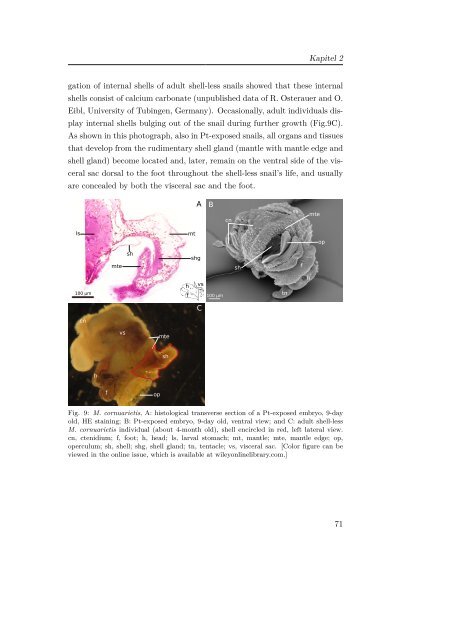Die Embryonalentwicklung der Paradiesschnecke ... - TOBIAS-lib
Die Embryonalentwicklung der Paradiesschnecke ... - TOBIAS-lib
Die Embryonalentwicklung der Paradiesschnecke ... - TOBIAS-lib
Create successful ePaper yourself
Turn your PDF publications into a flip-book with our unique Google optimized e-Paper software.
Kapitel 2<br />
gation of internal shells of adult shell-less snails showed that these internal<br />
shells consist of calcium carbonate (unpublished data of R. Osterauer and O.<br />
Eibl, University of Tubingen, Germany). Occasionally, adult individuals display<br />
internal shells bulging out of the snail during further growth (Fig.9C).<br />
As shown in this photograph, also in Pt-exposed snails, all organs and tissues<br />
that develop from the rudimentary shell gland (mantle with mantle edge and<br />
shell gland) become located and, later, remain on the ventral side of the visceral<br />
sac dorsal to the foot throughout the shell-less snail’s life, and usually<br />
are concealed by both the visceral sac and the foot.<br />
Fig. 9: M. cornuarietis, A: histological transverse section of a Pt-exposed embryo, 9-day<br />
old, HE staining; B: Pt-exposed embryo, 9-day old, ventral view; and C: adult shell-less<br />
M. cornuarietis individual (about 4-month old), shell encircled in red, left lateral view.<br />
cn, ctenidium; f, foot; h, head; ls, larval stomach; mt, mantle; mte, mantle edge; op,<br />
operculum; sh, shell; shg, shell gland; tn, tentacle; vs, visceral sac. [Color figure can be<br />
viewed in the online issue, which is available at wileyonline<strong>lib</strong>rary.com.]<br />
71
















